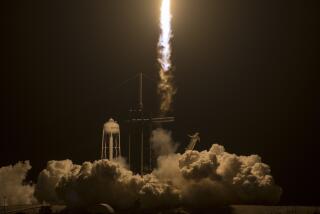Wayward Satellite Boosted High Enough for Possible Shuttle Rescue
- Share via
WASHINGTON — Engineers managed to shift a wayward private communications satellite out of harm’s way Friday, at least temporarily, and an aerospace company offered equipment for a possible salvage mission by a space shuttle.
Engineers were able to send the Intelsat 6 satellite to a higher orbit, where it won’t be subject to Earth’s atmosphere.
The satellite failed to separate from its launching vehicle, a commercial Titan 3 rocket, after liftoff from Cape Canaveral, Fla., on Wednesday and was trapped in a useless orbit that swung within 103 miles of Earth.
Rocket builder Martin Marietta Corp. on Friday attributed the failure to a wiring problem in the Titan 3 rocket that was “undetected by the processes and test procedures used in pre-launch checkout.”
Kerry Masson, a Martin Marietta spokeswoman in Denver, said a signal failed to make it from an on-board computer to the mechanism that was to separate the rocket and the satellite.
Without that separation, a motor attached to the satellite was unable to propel the spacecraft to its duty station 22,300 miles above Earth.
Intelsat, the international communications consortium that owns the $150-million uninsured satellite, fired small on-board thrusters and raised the satellite’s orbit by nearly 60 miles. That put the 5-ton satellite out of immediate reach of the atmosphere.
“Right now, we are concentrating on discussing with NASA the possibility of assistance,” said Tony Trujillo, spokesman for the 118-nation consortium. Such assistance would have to come from a space shuttle.
NASA had said it would not consider a rescue while the satellite was in a 103-mile-by-218-mile orbit. The low point of that orbit brushes the upper edge of the atmosphere, and the satellite was given only a nine-day life.
In its new orbit, 161 miles at the low point, the Intelsat satellite can stay in space for months. Moreover, because it had enough steering fuel to last for 13 years, there is ample fuel left to keep it out of the atmosphere, where it would slow down and burn.
Orbital Sciences Corp., a Virginia aerospace company, has offered use of a newly developed rocket assembly that can be attached to a stranded satellite in orbit.
The device, called a transfer orbit stage, or TOS, is designed to boost spacecraft from low Earth orbit to the 22,300-mile altitude at which communications satellites operate. The device was qualified for space flight in January.
“The TOS could be sent up in the shuttle, astronauts would attach it to the spacecraft and send it on its way,” said Robert Lovell, a vice president of Orbital Sciences.
More to Read
Sign up for Essential California
The most important California stories and recommendations in your inbox every morning.
You may occasionally receive promotional content from the Los Angeles Times.













